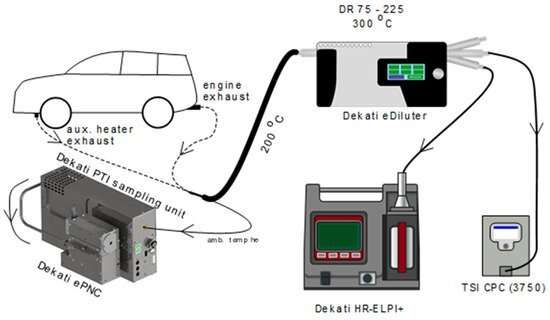Surprisingly high emissions from fuel-powered auxiliary heaters in cars

Heaters, sold under such well-known brand names as Webasto and Eberspächer, among others, are used in both passenger cars and heavy-duty vehicles to preheat the engine and provide additional cabin heating while driving. Emissions from heaters are not regulated, although they are widely used in especially colder regions, such as Finland. Therefore, they can have a significant impact on local air quality, and even on regional or global emissions budgets.
Researchers from Tampere University and the University of Eastern Finland studied the emissions of a total of eight selected vehicles equipped with an additional heater, either diesel or gasoline, depending on the car's propulsion power. Tests were carried out in collaboration with Dekati Ltd.
Postdoctoral Researcher Panu Karjalainen from Tampere University says that the results of the study show that the particulate emissions of auxiliary heaters can be up to a thousand times higher than the particulate emissions of idling gasoline vehicles. This raises the question of whether the use of heaters is justified with regard to the objective of reducing overall vehicle emissions. In addition, auxiliary fuel-fired heaters have been proposed as a solution for heating the cabin of electric vehicles so that it does not consume power from the battery, which in turn shortens the distance that a vehicle can drive on a single charge.
The researchers found that both gasoline and diesel heaters produced the highest particle concentrations immediately after start-up and shutdown. During the steady heating period, the particulate concentration in the emission remained at a constant level, which, however, was significantly higher than the emission from the idling of the car. In particular, in the case of diesel engines complying with the Euro 5b emission standard, all of which are equipped with a diesel particulate filter, emissions from auxiliary heaters are emphasized in relation to the very low particulate concentrations in the exhaust pipes. The results raise the question of whether the use of heaters is justified in view of emission reduction.
However, Senior Researcher Santtu Mikkonen from the University of Eastern Finland points out that the study does not take a position on the effect of additional heaters on engine cold-start emissions or the reduction of engine wear. Therefore, more research is needed to better investigate emissions and their environmental impact, and to make recommendations on the use and development of heaters.
More information: Panu Karjalainen et al, Fuel-Operated Auxiliary Heaters Are a Major Additional Source of Vehicular Particulate Emissions in Cold Regions, Atmosphere (2021). DOI: 10.3390/atmos12091105
Provided by University of Eastern Finland
















